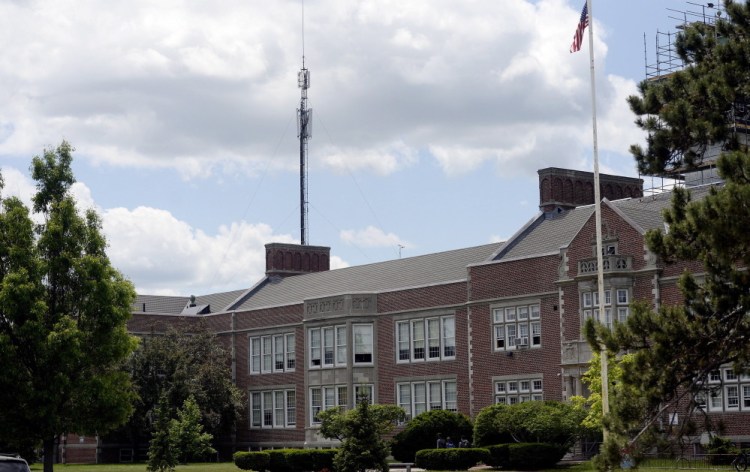Undeterred by recent tests showing that radio frequency emissions from a cell tower at Deering High School are well below federal standards, some teachers are trying to garner community support to remove the tower from the school’s roof.
In late May, Deering biology teacher Polly Wilson reported that goldfish she kept in Room 305, right below the tower, kept dying. She and other teachers concerned about the tower met with district officials, and then-Superintendent Emmanuel Caulk ordered the tests.
The reports from U.S. Cellular and C Square Systems of New Hampshire, which both tested the cell tower, found that the radio frequency levels were below federal standards, and in some cases were lower than earlier readings, according to Craig Worth, the school district’s deputy chief operations officer. The reports show that the readings in Wilson’s room ranged from .03 percent to 1.07 percent of the maximum permissible exposure under FCC standards.
“There’s absolutely no educational benefit having that tower on top of Deering. Let’s take it down. Let’s do the right thing,” said Gus Goodwin, Wilson’s husband and a technology teacher at King Middle School. Goodwin has been a leading advocate for removing the tower.
Goodwin said he has seen the reports, but still plans to meet with parent teacher organizations at Portland schools this fall to gather support to remove the tower, which has been in place since 2006.
In late May, 91 Deering High School staff members signed a “statement of concern” requesting that the cell tower be removed because it has no educational value, according to social studies teacher Kirsten Platt, who collected the signatures. The district gets about $36,000 a year from leasing the roof space to U.S. Cellular.
The findings from the recent reports do not change Platt’s position, she said Monday.
“There’s no study on long-term, low-exposure limits,” she said. “That’s my concern.”
The safety of radio frequency waves is a subject of long-standing dispute.
The Federal Communications Commission says radio frequency emissions from antennas used for cell towers result in exposure levels on the ground that are typically thousands of times below safety limits. The agency monitors RF radiation for possible impact on the environment, including human exposure, according to the FCC website.
However, critics of cell towers note that cellphone emissions are classified by the World Health Organization’s International Agency for Research on Cancer as possibly carcinogenic to humans. In a 10-year review of research, the agency didn’t find a causal relationship between radio frequency energy and cancer, but couldn’t rule out the possibility.
Experts note that radio frequency waves barely penetrate water and don’t damage DNA like X-rays do, but instead generate heat, in the same way that microwaves operate. An excessively high concentration of radio waves from a cell tower could, hypothetically, cause a burn or excessive heat.
The FCC allows an ERP – effective radiated power – of up to 500 watts per channel. Most cell towers in urban and suburban areas operate at an ERP of 100 watts per channel or less, according to the FCC website. The FCC last updated its guidelines for evaluating human exposure to RF fields from fixed antennas used for cellphone service in 1996.
Sometime this fall, Goodwin hopes to present the signatures and their findings to the school board.
“I guess it comes down to what people want to do. It’s really about what does the community think is the best thing to do, given what we know,” Goodwin said. “I would think it would be some kind of organized effort to get people to have a voice and say Portland Public Schools should probably have some kind of policy on Wi-Fi and cell towers.”
Wilson knows her experiments aren’t proof that the cell tower is causing the fish to die, and the reports indicate there is not a safety issue, but she still wants the tower removed.
“There is a larger conversation going on,” Wilson said. “Tech is so much a part of our lives that people don’t want to acknowledge that their phone, what they do all day, could in some way be not so good for them.”
TEACHER LEAVING OVER TOWER
Wilson said the situation is behind her decision to leave Deering and teach special education students at Reiche Elementary School this fall.
“It wasn’t just the fish. For three years, none of the projects worked the way they did before (the tower was installed.) I couldn’t teach science that way,” she said.
U.S. Cellular added three more antennas to the Deering tower array in 2011, for a total of six. The company issued a report after those additions, in January 2012, that found RF readings were below FCC safety standards throughout the building and school grounds. However, it did note that the highest readings inside the building were in Room 305.
Worth, the district’s deputy chief operations officer, said he thought the issue would eventually be brought before the school board for discussion. Acting Superintendent Jeanne Crocker was not available for comment on Monday.
Goodwin and Wilson said district officials had been very responsive to their concerns.
Representatives from U.S. Cellular did not respond to requests for comment about the Deering cell tower on Monday, but in emails to the district company officials said they had 22 towers located on schools, churches and hospitals in Maine and New Hampshire. The representative also noted that if the Deering tower were removed or turned off, there would be “significant coverage loss especially indoor coverage at the Deering High School and surrounding areas,” and it would “also impact customer’s ability to make emergency/911 calls in the area.”
Send questions/comments to the editors.





Success. Please wait for the page to reload. If the page does not reload within 5 seconds, please refresh the page.
Enter your email and password to access comments.
Hi, to comment on stories you must . This profile is in addition to your subscription and website login.
Already have a commenting profile? .
Invalid username/password.
Please check your email to confirm and complete your registration.
Only subscribers are eligible to post comments. Please subscribe or login first for digital access. Here’s why.
Use the form below to reset your password. When you've submitted your account email, we will send an email with a reset code.